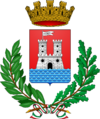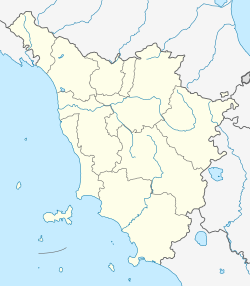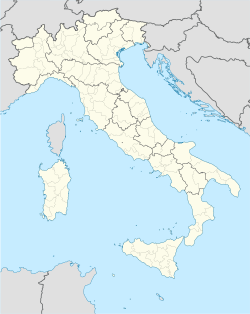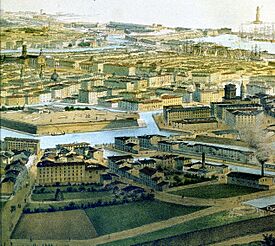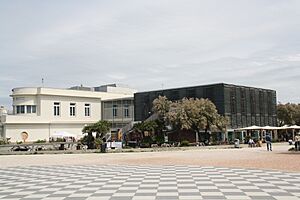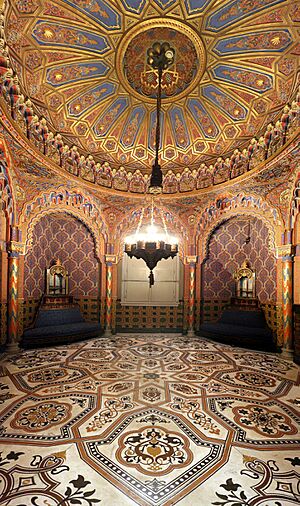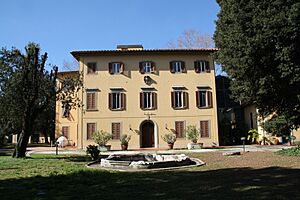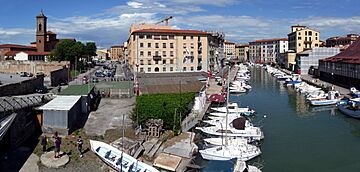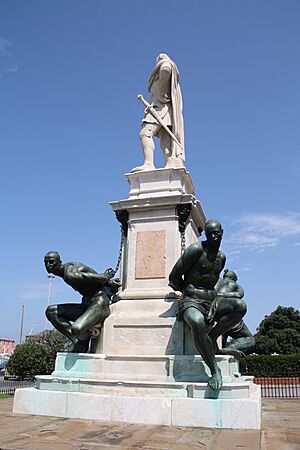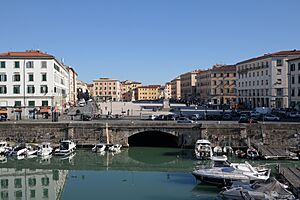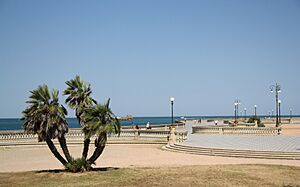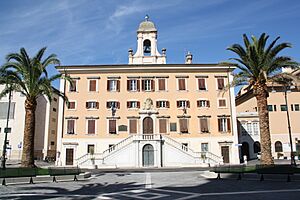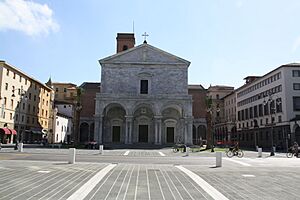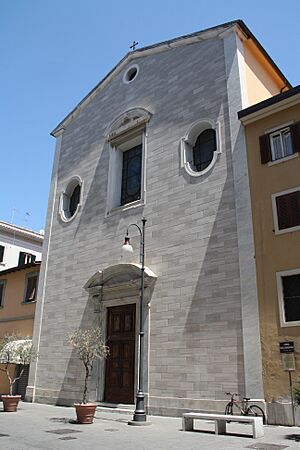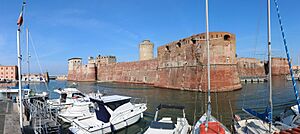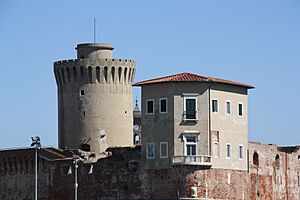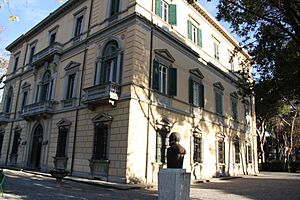Livorno facts for kids
Quick facts for kids
Livorno
Leghorn
|
|||
|---|---|---|---|
| Comune di Livorno | |||
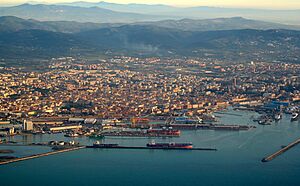
View of Livorno
|
|||
|
|||
| Country | Italy | ||
| Region | Tuscany | ||
| Province | Livorno (LI) | ||
| Frazioni |
List
Castellaccio, Gorgona, Limoncino, Quercianella, Valle Benedetta, Montenero
|
||
| Area | |||
| • Total | 104.8 km2 (40.5 sq mi) | ||
| Elevation | 3 m (10 ft) | ||
| Population
(1 January 2023)
|
|||
| • Total | 152,914 | ||
| • Density | 1,459.1/km2 (3,779.1/sq mi) | ||
| Demonym(s) | Livornesi Labronici |
||
| Time zone | UTC+1 (CET) | ||
| • Summer (DST) | UTC+2 (CEST) | ||
| Postal code |
57100
|
||
| Dialing code | 0586 | ||
| Patron saint | Julia of Corsica | ||
| Saint day | 22 May | ||
Livorno is a lively port city located on the western coast of Tuscany, a beautiful region in Italy. It sits right on the Ligurian Sea. Livorno is the capital of its own province, also called Livorno. In December 2017, it had about 158,493 people living there. You might also hear it called Leghorn in English.
During the Italian Renaissance, Livorno was designed to be an "ideal town". This means it was carefully planned out. Starting in the second half of the 16th century, the powerful House of Medici family helped Livorno grow a lot. It became an important free port, which meant goods could be traded there without extra taxes. Many foreign traders came to Livorno, making it a busy place for business. It was also home to many consulates and shipping companies, becoming the main port city for the Grand Duchy of Tuscany. Livorno was known for being a diverse city with many different cultures until the late 1800s. You can still see signs of this rich past in its many old churches, villas, and palaces.
Today, Livorno is seen as one of the most modern cities in Tuscany. It's the third largest city in the region, after Florence and Prato.
Contents
- Livorno's History
- Livorno's Climate
- Livorno's Population
- Livorno's Economy
- Main Sights to See
- Sports in Livorno
- Getting Around Livorno
- Education in Livorno
- Media in Livorno
- Famous People from Livorno
- International Connections
- Images for kids
- See also
Livorno's History
Early Beginnings
The exact beginnings of Livorno are a bit of a mystery, but people have lived here since the Neolithic Age (the New Stone Age). We know this from old bones, copper pieces, and pottery found in the Livorno Hills. The Etruscans had a settlement here called Labro.
When the Romans took over the area, they built the Via Aurelia road. They also left behind place names and old tower ruins. The natural bay here was called Liburna, named after a type of fast ship, the liburna, used by the Roman navy. The famous Roman speaker Cicero even mentioned Liburna in a letter.
Medieval Times
Livorno was first mentioned in writing in 1017 as a small village by the coast. It had a port and the remains of a Roman tower, and was ruled by Lucca. In 1077, a new tower was built by Matilda of Tuscany. Later, the Republic of Pisa took control of Livorno in 1103. They built a square fort called Quadratura dei Pisani (meaning "Quarter of the Pisans") to protect the port. However, Pisa's main port, Porto Pisano, was destroyed after a big naval battle in 1284 called the Battle of Meloria.
In 1399, Pisa sold Livorno to the Visconti of Milan. Then, in 1405, it was sold again to the Republic of Genoa. Finally, on August 28, 1421, the Republic of Florence bought it. The name 'Leghorn' comes from the Genoese name Ligorna. The name 'Livorno' was definitely used by Florentines in the 1700s.
Around 1427-1429, a count showed that 118 families lived in Livorno, totaling 423 people. The only part of medieval Livorno still standing today is a small piece of two towers and a wall, found inside the Fortezza Vecchia.
The Medici Family's Influence (1500–1650)
When the Medici family came to power in Florence, they made big changes in Livorno. Between 1518 and 1534, the Fortezza Vecchia (Old Fortress) was built. The Medici family also encouraged people to move to Livorno. Even with these efforts, Livorno was still a small coastal fort. By 1551, its population had grown to 1,562 people.
In 1577, the architect Bernardo Buontalenti created the first plan for Livorno. He designed a new fortified town with a pentagonal (five-sided) shape, which is why it's called Pentagono del Buontalenti. This new design included the original village. The Porto Mediceo (Medici Port) was protected by towers and forts leading to the city center.
In the late 1580s, Ferdinando I de' Medici, Grand Duke of Tuscany, made Livorno a free port. This meant that goods traded there were tax-free within the city's control.
In 1593, the Duke's government created the Leggi Livornine (Livornese Laws) to manage trade. These laws protected merchants and helped international trade. They also promoted tolerance, offering freedom of religion and amnesty to many people. The Grand Duke attracted many different groups, including Turks, Persians, Moors, Greeks, Armenians, and Jews. Many Sephardic Jews came to Livorno in the late 1500s after being forced out of Spain and Portugal. Livorno gave them rights and special treatment, and they helped the city become very wealthy and a center of learning.
Livorno became a very modern and open European city, and one of the most important ports in the entire Mediterranean Basin. Many foreigners from Europe moved there, including French, Dutch, English, and Orthodox Greeks. On March 19, 1606, Ferdinando I de' Medici officially made Livorno a city.
In 1653, a naval battle, the Battle of Leghorn, was fought near Livorno during the First Anglo-Dutch War.
Later Centuries
At the end of the 1600s, Livorno grew a lot with new city planning. A new fortress and city walls were built, along with a system of canals. After the port of Pisa became unusable in the 1200s, Livorno took over as the main port in Tuscany. By 1745, Livorno's population had grown to 32,534 people.
European countries, especially Britain with its Levant Company, set up trading posts in Livorno. This led to more trade and cultural connections. Many British writers, artists, and travelers visited the area, creating special ties between the two communities. The British called the city "Leghorn."
During the Italian campaigns of the French Revolutionary Wars in the late 1700s, Napoleon's troops took over Livorno and the rest of Tuscany. Under Napoleon's rules, trade with Britain was stopped, which hurt Livorno's economy. After the Congress of Vienna, Austrian rule replaced the French.
In 1861, Italy became a unified country. At that time, Livorno had 96,471 residents. Livorno and Tuscany became part of the new Kingdom of Italy. However, Livorno lost its special status as a free port, and its importance in trade decreased.
In the 1800s and 1900s, Livorno gained many public parks and important museums like the Museo Civico Giovanni Fattori and the Museo di storia naturale del Mediterraneo.
Livorno suffered a lot of damage during World War II. Many historic places and buildings, including the cathedral and Synagogue of Livorno, were destroyed by bombs.
Since the late 1900s, Livorno's residents have been known for their left-wing politics. The Italian Communist Party was even founded in Livorno in 1921.
Livorno's Climate
Livorno has a hot-summer mediterranean climate. This means summers are warm, and the heat often stays through the night. Winters are mild because of the warm influence from the Mediterranean Sea. Most of the rain falls in winter, and summers are dry, which is typical for Mediterranean climates.
| Climate data for Livorno | |||||||||||||
|---|---|---|---|---|---|---|---|---|---|---|---|---|---|
| Month | Jan | Feb | Mar | Apr | May | Jun | Jul | Aug | Sep | Oct | Nov | Dec | Year |
| Record high °C (°F) | 19.6 (67.3) |
21.5 (70.7) |
24.1 (75.4) |
25.6 (78.1) |
32.2 (90.0) |
35.4 (95.7) |
37.8 (100.0) |
36.0 (96.8) |
33.6 (92.5) |
28.8 (83.8) |
25.0 (77.0) |
21.5 (70.7) |
37.8 (100.0) |
| Mean daily maximum °C (°F) | 10.8 (51.4) |
12.0 (53.6) |
14.3 (57.7) |
17.2 (63.0) |
21.0 (69.8) |
24.9 (76.8) |
27.7 (81.9) |
27.5 (81.5) |
24.8 (76.6) |
20.2 (68.4) |
15.3 (59.5) |
11.8 (53.2) |
19.0 (66.1) |
| Mean daily minimum °C (°F) | 4.8 (40.6) |
5.4 (41.7) |
7.5 (45.5) |
10.2 (50.4) |
13.7 (56.7) |
17.4 (63.3) |
20.0 (68.0) |
19.9 (67.8) |
17.3 (63.1) |
13.3 (55.9) |
9.1 (48.4) |
6.1 (43.0) |
12.1 (53.7) |
| Record low °C (°F) | −7.0 (19.4) |
−6.6 (20.1) |
−4.8 (23.4) |
0.1 (32.2) |
3.0 (37.4) |
7.8 (46.0) |
11.6 (52.9) |
10.8 (51.4) |
5.0 (41.0) |
0.6 (33.1) |
−1.7 (28.9) |
−5.4 (22.3) |
−7.0 (19.4) |
| Average precipitation mm (inches) | 68 (2.7) |
60 (2.4) |
69 (2.7) |
60 (2.4) |
54 (2.1) |
40 (1.6) |
18 (0.7) |
31 (1.2) |
73 (2.9) |
104 (4.1) |
102 (4.0) |
80 (3.1) |
759 (29.9) |
| Average precipitation days | 8 | 8 | 9 | 8 | 7 | 4 | 2 | 3 | 6 | 9 | 10 | 10 | 84 |
Livorno's Population
Livorno is home to people from many different countries. As of December 31, 2020, the largest groups of foreign-born residents were from Romania, Albania, Ukraine, Peru, and Senegal.
| Country of birth | Population |
|---|---|
| 2,163 | |
| 1,690 | |
| 830 | |
| 792 | |
| 766 | |
| 685 | |
| 527 | |
| 510 | |
| 400 | |
| 399 | |
| 334 | |
| 284 | |
| 227 | |
| 212 | |
| 208 | |
| 163 | |
| 137 | |
| 136 | |
| 133 | |
| 127 | |
| 107 |
Diverse Communities
Livorno has a long history of welcoming different communities.
Armenian Community
In 1591, Ferdinando I de' Medici invited Armenians to settle in Livorno to boost trade. By the early 1600s, Armenians ran 120 shops in the city. In 1701, the Armenian community, who belonged to the Armenian Apostolic Church, got permission to build their own church. It was dedicated to Gregory the Illuminator. The church was finished a few years later but opened for worship in 1714. It was damaged in World War II and partly restored in 2008.
Greek Community
The first Greeks came to Livorno in the early 1500s. They were often soldiers who served in the fleet of Cosimo de' Medici. This community grew a lot in the 1700s and 1800s, as Livorno became a major trading center in the Mediterranean. Many new Greek immigrants came from western Greece and other areas.
Because Livorno was a free port, it was a very important place for Greek merchants. They traded goods from the Black Sea and the Mediterranean Sea to places like England and the Ottoman Empire. By the 1820s, Greek business owners became very important in Livorno's trade.
The Greek community had its own special culture, based on their Greek Orthodox religion, language, and history. In 1775, they built the Church of the Santissima Trinità, Livorno, which was the second non-Catholic church in Tuscany. They also started a Greek school. The community helped raise money for the Greek War of Independence in 1821. After Italy became a unified country in 1861, the Greek community in Livorno became smaller because the free port benefits ended.
Jewish Community
Livorno has a rich Jewish community. Many Sephardic Jews came here after being expelled from Spain and Portugal in the late 1400s. Livorno offered them special rights, and they played a big part in the city's trade and learning.
Local Dialects
Livorno has its own unique ways of speaking Italian.
Vernacolo
People in Livorno speak a version of the Italian Tuscan dialect called vernacolo. There's even a funny magazine called Il Vernacoliere that's mostly written in this Livornese dialect.
Bagitto
The bagitto was a special Jewish-Italian dialect once spoken by the Jewish community in Livorno. It was based on Italian but included words from Tuscan, Spanish, Portuguese, Hebrew, and Yiddish. This mix of languages came from the different places the first Jewish people in Livorno had lived.
Livorno's Economy
Port of Livorno
The city and its port are still very important. Many cruise ships visit Livorno, bringing thousands of passengers. These visitors often take buses to famous nearby cities like Florence, Pisa, and Siena.
Some of the cruise lines that visit Livorno include:
- AIDA Cruises
- Azamara Club Cruises
- Carnival Cruise Lines
- Celebrity Cruises
- Costa Crociere
- Cunard Line
- Holland America Line
- MSC Cruises
- Norwegian Cruise Line
- P&O Cruises
- Princess Cruises
- Pullmantur Cruises
- Royal Caribbean Cruises Ltd.
- Silversea Cruises
- Thomson Cruises
- Viking Ocean Cruises
Shipyards
Since 1866, Livorno has been known for its shipyards, especially the Cantiere navale fratelli Orlando. This company builds and repairs ships. In 2003, Azimut-Benetti took over the Orlando shipyard.
Eni Petrochemical Plant
The Eni plant in Livorno makes important fuels like gasoline, diesel fuel, and lubricants. The original refinery was built in 1936 but was destroyed during World War II. It was rebuilt and now processes 84,000 barrels of oil each day. The refinery is connected to the oil dock and other fuel depots by pipelines.
Leonardo Defense Systems
The former Whitehead Alenia Sistemi Subacquei (WASS) plant in Livorno made torpedoes (underwater weapons), anti-torpedo systems for submarines and ships, and sonar systems. This factory was started by Robert Whitehead in 1875. It became part of the Fiat Group in 1979 and then Finmeccanica in 1995. Today, it is owned by Leonardo S.p.A..
Financial District
Livorno also has an important financial area, mostly on Via Cairoli. This street is home to many banks, financial companies, insurance companies, and the Post Office Building.
Tuaca Liqueur
The famous Tuaca liqueur was made in Livorno until 2010. Another well-known liqueur, Galliano, is still produced here.
Main Sights to See
Museums and Gardens
Livorno Aquarium
The Livorno Aquarium, named after Diacinto Cestoni, is the biggest aquarium in Tuscany. It's located by the Terrazza Mascagni on the seafront. It first opened in 1937, was rebuilt after World War II, and fully reopened in 2010. The aquarium has 33 tanks with 2,000 animals from 300 different species. You can see creatures from the Mediterranean, Indo-Pacific, and Caribbean seas.
Giovanni Fattori Civic Museum
This museum is dedicated to the painter Giovanni Fattori. It mainly shows modern art from the 1800s. The museum opened in 1994 inside Villa Mimbelli, an 18th-century building with a large park. The museum started in 1877 to collect art from Livorno.
Yeshivà Marini Jewish Museum
The Yeshivà Marini Museum is in a beautiful old building that was once a place of worship. It was used as a synagogue after World War II while a new one was being built. The museum has a collection of religious items from the old Synagogue, which was destroyed in the war. These items show the rich history of the Jewish community in Livorno.
Mediterranean Natural History Museum
This museum started in 1929, but many of its items were lost in World War II. It reopened in 1980 in Villa Henderson. The museum has different sections about humans, sea creatures, and flight in nature. It also has a Planetarium.
Mascagni Museum
The Museo Mascagnano holds items, documents, and operas by the famous composer Pietro Mascagni, who lived in Livorno. His operas are often performed at the Goldoni Theatre. The Terrazza Mascagni on the seafront is also named in his honor.
Mediterranean Botanical Garden
The Orto Botanico del Mediterraneo is a botanical garden located on the grounds of the Museo di storia naturale del Mediterraneo. It's a great place to see different plants.
Interesting Places and Buildings
Venezia Nuova District
In 1629, Ferdinando II de' Medici decided to make Livorno bigger. He wanted to expand the city northwards to create more space for sea trade. This new area, called Venezia Nuova (New Venice), was built on land reclaimed from the sea. It has many canals and is connected to the rest of the city by bridges. Venetian workers were hired to help build it.
Venezia Nuova became the district where foreign consuls and important international traders lived. Their warehouses were filled with goods from all over the world. The buildings along the canals often had small towers where people could watch for ships. They also had ground-floor entrances for easy unloading of goods from boats.
Today, the Venezia Nuova district still looks much like it did originally. It has its old bridges, narrow lanes, noble houses, and churches like Santa Caterina da Siena and San Ferdinando. The canals once connected its warehouses directly to the port.
Monument of the Four Moors
The Monument of the Four Moors is one of Livorno's most famous landmarks. It's dedicated to Ferdinando I de' Medici. Ferdinando I asked Giovanni Bandini to create a white Carrara marble statue of himself in 1595. This statue was finished in 1599.
Later, Ferdinando I wanted to add four statues of prisoners to the monument's base. He gave this job to Pietro Tacca in 1602. The first two statues were made in Florence in 1622. The other two were added in 1626. During World War II, the monument was moved to a safe place to protect it from bombs. It has been restored recently in 1990 and 2013.
Leopoldine Aqueduct
The Acquedotto Leopoldino and the neoclassical cisterns of Livorno were part of a clever system to bring water to the city.
The Great Cistern
La Gran Conserva, also known as Il Cisternone, is the largest and most famous of Livorno's covered cisterns. It's located on what used to be the edge of the city in the 1800s.
City Cistern
Cisternino di città is a simple, classical-style cistern. Its design was approved in 1837 and it was finished in 1848.
Republic Square
In the early 1800s, Livorno needed to connect its old Medici-era roads to the new eastern parts of the city. The solution, built in 1844, was to cover the Fosso Reale (Royal Canal) with a huge vault, creating a large oval-shaped square. The canal underneath remained open for boats.
This new square was first called Piazza del Voltone (Vault Square) and then Piazza dei Granduchi (Grand Dukes' Square). After Italy's unification, it was named Piazza della Repubblica (Republic Square) in 1946. The square is decorated with marble benches and pillars, and two statues.
Mascagni Terrace
The Terrazza Mascagni is a large, curving viewpoint overlooking the sea. From here, you can see the Livorno hills, the Tuscan Archipelago, Corsica, and the Port of Livorno. It was built between 1925 and 1928 and has a unique checkerboard pattern made of 34,800 black and white tiles. It also has 4,100 balusters (small pillars). A gazebo for music used to be here but was destroyed in World War II. In 1937, the Livorno Aquarium was built nearby. After the war, the Terrazza was named after Pietro Mascagni. It was fully restored in 1994, with the gazebo rebuilt in 1998.
Town Hall
Livorno became a city on March 19, 1606. The first town meetings were held in a church. In 1646, a building was bought to serve as the Community's headquarters, but it was too small. So, in 1720, they decided to build a new town hall.
This new palace was partly destroyed by an earthquake in 1742. It was rebuilt and expanded over the years. It was damaged again by bombs during World War II but was restored and reopened in 1949.
Religious Buildings
Cathedral of Saint Francis of Assisi
The main church of Livorno, called the Duomo di Livorno, is dedicated to Francis of Assisi, Mary, and Julia of Corsica. It was built in the center of the Pentagono del Buontalenti area. Building started in 1581. The church had a rectangular shape with one main aisle. The original wooden ceiling, made between 1610 and 1614, had seven paintings. The front of the church had a simple marble porch.
The church was officially opened on February 19, 1606. In 1629, it became a collegiate church. The church's shape was changed in 1716 when two side chapels were added. The bell tower, 50 meters high, was added in 1817.
Sadly, the cathedral was completely destroyed by Allied bombs in 1943 during World War II. It was rebuilt to look like the original, except for two new marble porches. It was opened again on December 21, 1952. Since 2006, a painting called "Christ Crowned with Thorns" by Fra Angelico has been displayed in the Chapel of the Eucharist.
Church of the Madonna
The Church of the Madonna is on a street that connects the city center to the Venezia Nuova district. Legend says the church was built to house a statue of Our Lady of Mount Carmel taken from a Turkish ship. It was an important place of worship for foreign communities. Building began in 1607 and was finished in 1611. The church has a rectangular shape with one main aisle. On each side, there are three altars for different foreign communities. The simple front of the church was covered in white marble in 1972.
Church of the Most Holy Annunciation
The Church of the Most Holy Annunciation is also on Via della Madonna. It was a place of worship for the Greek community who followed the Byzantine Rite. Many Greeks came to Tuscany in the late 1500s. The church was built in 1601 and finished in 1605. Its baroque front was added in 1708. The inside has one main aisle and a beautiful wooden Iconostasis (a screen with icons) from 1641. The church was completely destroyed by bombs in World War II and was restored in 1985.
Other Religious Sites
- Santa Caterina da Siena: A Baroque church in the Venezia Nuova district.
- San Ferdinando: Another Baroque church in Venezia Nuova.
- San Giovanni Battista: A Baroque-Mannerist church in central Livorno.
- Santa Maria del Soccorso: A Neoclassical church in central Livorno, known for its tall brick front and surrounding park.
- Old English Cemetery: The oldest foreign Protestant burial ground in Italy, started around 1645. Many famous people are buried here. It closed in 1839, and a new one opened.
- Sanctuary of Montenero: A Marian sanctuary on a hill outside Livorno, dedicated to Our Lady of Graces, the patron saint of Tuscany. It's a popular place for pilgrims and has a gallery with many ex-voto (offerings), mostly related to miraculous sea rescues.
- Temple of the Dutch German Congregation: Also known as the Dutch-German Church, located on the Fosso Reale canal.
- Synagogue of Livorno: The main Jewish place of worship in Livorno.
Military Architecture
Old Fortress
The Fortezza Vecchia (Old Fortress) is near what was once Porto Pisano (Pisan Port). A square tower was built here in 1077. In 1241, the Pisans built a large cylindrical tower, 30 meters high. In 1377, the Pisans built a square fort called Quadratura dei Pisani to defend the port. This fort was connected to a wall in 1392 to protect the town. Florence bought Livorno in 1421.
The project to build the Fortezza Vecchia was given to Antonio da Sangallo the Elder in 1506. The fortress was designed to include the existing Pisan and Genoese buildings.
Construction started in 1518 and was finished on April 1, 1534. It's a huge fortress made of red brick with sloping walls. It has a four-sided shape with a perimeter of 1500 meters and had 24 cannons to protect it. One corner connects to the older Pisan and Genoese structures. The other three corners are protected by triangular bastions. The land facing the town was dug out so the fortress was surrounded by the sea for better defense. The Medici family built palaces inside the fortress. The Fortezza Vecchia was used for military purposes for a long time.
New Fortress
The Fortezza Nuova (New Fortress) was built in the late 1500s. It was part of a new city plan by Bernardo Buontalenti to give Livorno a pentagonal shape surrounded by canals.
The original plan was changed to allow for the building of the Fortezza Nuova to make the city's defenses stronger. Construction started on January 10, 1590, and finished in 1604. It's a large fort made of stone and red bricks, with a many-sided shape surrounded by water.
In 1629, part of the fortress was taken down to allow for the building of the Venezia Nuova and San Marco districts. The Fortezza Nuova was used for military purposes until the end of World War II. It was heavily damaged during the war. After restoration in 1972, the top part is now a public park and a place for events.
Buontalenti's Pentagon
In 1575, Francesco I de' Medici asked Bernardo Buontalenti to design an ideal town for Livorno. The goal was to turn Livorno from a fishing village into a fortified city that could hold 12,000 people and become a major trade center. Buontalenti designed a five-sided city, common in the Renaissance, with defensive walls, ramparts, and five bastions (strong points) at the corners. The city was surrounded by canals.
Construction began on March 28, 1577. Livorno became a city surrounded by the navigable Fosso Reale (Royal Canal), with many palaces, warehouses, and customs houses. The main street was Via Ferdinanda, later called Via Grande. In 1594, a large square was created in the middle of Via Ferdinanda to build the city's main church. This square, Piazza d’Arme (later Piazza Grande), was completed in 1602.
The Italian Naval Academy in Livorno is a military university that trains officers for the Italian Navy. Both men and women attend this academy.
Sports in Livorno
- U.S. Livorno 1915: This is a semi-professional football club that plays in the Serie D league. Their home games are played at the Stadio Armando Picchi.
- Pallacanestro Don Bosco Livorno: Founded in 1996, this is an amateur basketball club. As of April 2017, they play in the Serie C Gold league.
Livorno also has its own rugby and American football teams.
Getting Around Livorno
Airport
The closest airport is Pisa International Airport, which is about 20 kilometers (12 miles) away. It's the main airport for Tuscany.
Buses
Livorno has had a public transport system since 1875. Today, the bus network is run by Autolinee Toscane. They operate two main High Mobility Lines, seventeen urban lines, one school line, and six routes that connect Livorno to other towns in the Province. Autolinee Toscane also runs a funicular (a type of cable car) that connects lower Montenero to the Sanctuary.
Port
The Port of Livorno is one of the largest seaports in Italy and the Mediterranean Sea. Many ferry companies operate from here, connecting Livorno to other cities:
- Corsica Ferries - Sardinia Ferries goes to Golfo Aranci and Bastia.
- Grimaldi Lines goes to Barcelona and Tangier.
- Moby Lines goes to Olbia and Bastia.
- Toremar goes to Capraia.
Trains
The city is served by the Livorno Centrale station, making it easy to travel by train.
Education in Livorno
Schools
"Galileo Galilei" Industrial Technical Institute
The Industrial Technical Institute named after Galileo Galilei was founded in 1825. It was originally a School of Arts and Crafts, training young people for jobs in mechanics and decorative arts. Over the years, it added more subjects like electrical engineering, chemistry, physics, electronics, biology, nuclear physics, and informatics. The institute has many laboratories, special classrooms, a library, and gymnasiums.
"Alfredo Cappellini" Nautical Institute
The Nautical Institute Alfredo Cappellini was established on December 13, 1863. It was the first Technical Institute in the Province of Livorno. This school trains officers for the Merchant navy.
"Niccolini Palli" Classical High School
The Liceo Classico Niccolini was founded on March 10, 1860. It was named after Giovanni Battista Niccolini. A famous professor here was Giovanni Pascoli, who taught Greek and Latin from 1887 to 1895. Some well-known students who attended this school include Pietro Mascagni, Guglielmo Marconi, Amedeo Modigliani, and Carlo Azeglio Ciampi, who later became a teacher there.
Library
Labronica Library
The Biblioteca Labronica (Labronica Library) was founded in 1816. It became a public library in 1840 and was given to the city in 1854. The library is named after Francesco Domenico Guerrazzi and is located in Villa Fabbricotti. This villa is said to have been a suburban home for Ferdinando II de' Medici. The library's storage holds 120,000 books, 1,500 manuscripts, 117 incunables (very early printed books), and 60,000 autographs. It also has a collection of autographs from famous people like Galileo Galilei and Giacomo Leopardi, and old books printed in Livorno since the 1600s.
Media in Livorno
- Il Tirreno: This is a regional newspaper printed and published in Livorno. It has many local editions across Tuscany.
- Il Vernacoliere: This is a funny monthly magazine printed in Livorno. It was founded in 1982 and is sold in central Italy.
Famous People from Livorno
Many notable people have come from Livorno, including:
- Massimiliano Allegri (born 1967), a famous football coach.
- Giorgio Chiellini (born 1984), a well-known football player.
- Carlo Azeglio Ciampi (1920–2016), who was a former President of Italy.
- Giovanni Fattori (1825–1908), a celebrated painter.
- Cristiano Lucarelli (born 1975), a football player who was a top scorer.
- Pietro Mascagni (1863–1945), a world-famous opera composer.
- Amedeo Modigliani (1884–1920), a painter and sculptor known for his unique style.
- Aldo Montano (born 1978), an Olympic gold medalist in fencing.
- Nedo Nadi (1894–1940), who won 5 gold medals in fencing at the 1920 Olympics.
- Paolo Virzì (born 1964), a film screenwriter and director.
International Connections
Livorno has special connections with other cities around the world. It is twinned with:
 Bat Yam, Israel
Bat Yam, Israel Guadalajara, Spain
Guadalajara, Spain Haiphong, Vietnam
Haiphong, Vietnam Novorossiysk, Russia
Novorossiysk, Russia Oakland, U.S.
Oakland, U.S.
Images for kids
See also
 In Spanish: Livorno para niños
In Spanish: Livorno para niños



